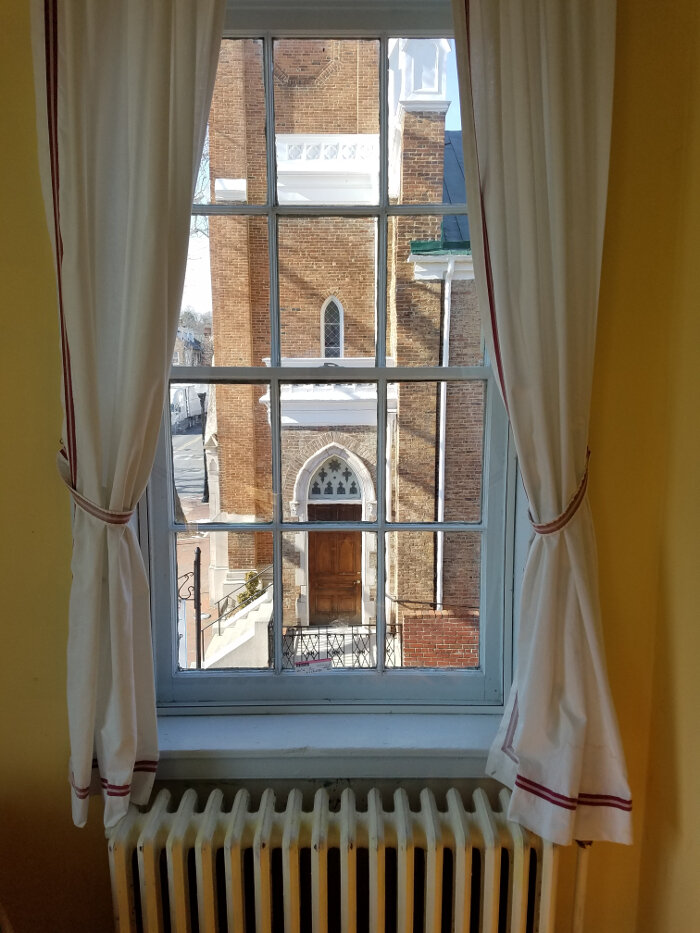How To Prevent Winter Heat Loss Through Windows and The Attic In Historic Homes
The image is iconic. An old fashioned wood frame window, miniature snow drifts neatly cresting in the bottom corners of the panes, the rest of the glass artfully decorated by Jack Frost, all juxtaposed against warm reassuring radiance from a cozy living room or den.
In visual depictions, the wintry window is the plane that separates the whirling winds from balmy blissfulness. Chromatically bleak blues and greys streak the outside world while within warm yellows and oranges radiate from a roaring fire on a hot hearth.
When the temperatures tumble, the appeal is self-evident. Though increasingly a thing of the past, for centuries freezing folks spent whole winters waking to frost-painted window panes. In the first half of the 19th Century, it is almost certain that the glass of the window was frosted-over.
Though quaint, and apparently profitable, this image records the enormous inefficiency of older windows.
One of the burdens of being a home inspector is that it is almost impossible to turn Inspection Mode off, and sometimes this ruins things.
I watched a murder mystery this fall that was supposed to be set in the 1890s, but in a number of the scenes, set in basements and warehouses, plywood subflooring could be seen where plank subflooring should have been.
Inauthenticity. The illusion was shattered. Don’t let anyone tell you this job is easy.
Likewise, when I see picturesque panes feathered with frost in books and movies, I am little assuaged by the glow of the fire and have to suppress my desire to lecture about the heat being lost through the windows.
It is, of course, news to nobody that windows are a central source of heat loss.
Why they are and what to do about it, however, are more involved lines of inquiry.
Single Pain Windows
In my travels throughout the northern Shenandoah Valley, I really don’t see a consistent application of double glazed windows in houses built before the early 1980s.
When I do see double glazing in houses more than forty years old, it is usually because the windows have been replaced.
Having two sealed panes of glass instead of one only slightly increases the insulating value of a window (think ability to arrest temperature transfer), but it does a tremendous job of stopping air leakage between the sash and the glass. It also keeps the warmer interior air with a higher moisture content from sweating and freezing on the outside glass - the two key ingredients Jack Frost needs.
I’ve discussed the ways in which air leakage cuts into the comfort of an otherwise well-heated room. And while, broken glass or worn seals can degrade double glazed windows, it is the older single pane windows that pose more problems in our area.
Now, from the standpoint of pure functionality, I will tell you that window replacement is the best route.
If you are going for maximum energy efficiency, nothing beats new, well-installed windows – except no windows – which means embracing life in a bunker; and I imagine it is hard to get friends to come over when you live in a bunker.
For homeowners with older, single pane windows, however, freeing and cave-dwelling aren’t the only options.
In order to build a good understanding of what to do with leaky old windows, let’s back-up and look at why single pane windows problematic.
Single pane windows are a product of the materials available (or prevalent) when they were made. Thus, in the 18th century, when glass windows were still something of a luxury item, panes were small because the glass was often hand-blown. As glass production reached some semblance of its modern form in the 19th century, larger plates with a more even depth could be made.
Regardless of the size of the glass, windows through World War II were predominantly framed with wood. The glass would be cut to fit the opening between the surrounding vertical and horizontal sash pieces or between the mullions (the smaller pieces that subdivide the top and bottom sash). The individual pieces of glass would be held in place with small nails or tacks and then sealed with glazing putty, traditionally a mixture of finely ground caulk and linseed oil.
The annoying part, from a modern perspective, is that glazing putty has to be replaced periodically. The sun and wind dry and crack it, until it falls out altogether. Once the glazing putty has been compromised, wind and weather quickly find their way into the interior.
As you already know, single pane windows hold little insulating value.
Insulation is measured in R-values.
For example, the current standard for attic insulation across Virginia is R-38. Wall insulation ranges between R-19 and R-24.
The rating for a single pane of glass is R-1!
Combine that with air leaks around the glass and you’ll realize how irritatingly inefficient old windows are: They are perilously close to just being holes in the wall!
In the days when fuel, be it wood, coal, or petroleum based, was cheap, those who had the means could just overcompensate through conspicuous consumption.
Nowadays, treating your thermostat like an accelerator is not considered very ecologically responsible and can be exorbitantly expensive.
Homespun remedies are another option. Sealing windows with plastic can cut down on the air leakage, but the application can be annoying, the result unsightly and irregular. Hanging blankets on the inside of your windows has a medieval flavor to it, but can also give your home that dark bunkered effect that scares the neighbors and gives rise to urban legends. Remember, endorphins are a good thing.
Storm Windows
Aside from replacing single-pane windows, the best way to address their leakiness is through the use of storm windows.
If installed correctly, these come close to creating an air block as effective as double paned windows. The deterring drawback of storm windows is their appearance. Newer vinyl and aluminum models often clash with the classic styling of older homes. Wooden storm windows can be less jarring visually, but often suffer from the same issues as the windows they protect. And like any exterior finish or material, storm windows of any ilk wear out over time.
I see lots of 30+ year old storm windows that aren’t doing much more than trapping insects in the summer.
Fairytale Windows With Nightmarish Consequences
Sometimes, too, people don’t want to replace their old windows. Often, after sternly critiquing the shortcomings of some rattling old windows, the buyer or buyers will respond by saying, “yeah, but look at that glass”.
People love wavy old glass.
Like the fairytale frost on the windows at first light, I have inspected for no shortage of folks who see only the quaint craftsmanship of old glass and worn wood. Needless to say, this bygone beauty vanishes into thin air as soon as the first heating bill arrives, but who am I to be critical of people’s aesthetic inclinations.
In other instances, houses in historic areas are sometimes subject to regulations restricting their appearance. Though it doesn’t make any sense from the perspective of functionality, exterior storm windows aren’t always allowed.
Enter the interior storm window.
Interior storm window? But storms are on the outside, right?
Yes, and if it’s raining inside your home you’ve got bigger problems than leaky windows. Though the name is a bit unexpected, it’s no oxymoron. Interior storm windows do, in fact, function in much the manner as conventional exterior storm windows.
Instead of going on the outside, interior storm windows cover both of the sashes on the inside face of a window. They are made of glass or Plexiglas and have their own frame that gets screwed to the window frame. Being on the inside, they don’t protect the exterior face of the existing window as conventional storm windows do, but, in terms of stopping air leakage, they have a handful of distinct advantages.
First, the interior face of most windows is more even and regular than the exterior because it’s not exposed. This means that a better seal against the mounting surface can be made, making them superior leak-stoppers.
Second, interior storm windows don’t get the wear and tear that their exterior counterparts do – unless you’re playing ball in the house - and you know you’re not supposed to do that.
Below are some pictures of the interior storm windows that were recently installed in a building in downtown Winchester.
The building is from the first half of the 19th century and has old wood frame, single pane windows.
As you’ll notice from the pictures, the interior storms are almost invisible from the exterior. The historic façade remains unchanged. Even from the interior, the storm windows are very unobtrusive.In effectively arresting the air leakage of the antique windows, people have already experienced a noticeable increase in comfort since their installation.
In addition to quelling cold spots, the decrease in fuel expenditure should amortize the cost of the installation in just a few winters.
My grandfather grew up in upstate New York in the 1930s, and he claimed that in the winter the top blanket on his bed would be frosty in the morning. I know older folks frequently get accused of heaping hyperbole into their recounting of earlier events, but I have no reason to doubt this story. My grandfather never wore gloves and I don’t recall him ever going out in more than a jacket on even the coldest days. He had a certain imperviousness to the winter weather.
The point, however, is that once upon a time windows were (some still are) a stupendous source of heat loss. Short of complete window replacement, interior storm windows are an option for those looking to make their homes more comfortable and save some money.
What To Do With Winter Winds
As a little kid, I was pretty sure that Winchester got its name from the windiness of our winters.
When your wet hair freezes at the bus stop and you go to sleep listening to the whistling around the windows, it makes sense. It turns out that my childhood etymology was a bit off; nevertheless, the windchill factor around here undeniably turns frigid into freezing.
Current thinking claims that the name comes from either Brittonic word ouenta (favored place) or venta (town, meeting place) being paired with the Latin castrum, meaning camp. Old English: In Old English this became Uintancæstir.
For the budget conscious, blustery breezes have a direct effect on how well we can keep our homes warm in the winter – and how much we have to pay to achieve this.
A few weeks ago, we took the whole-house fan out of the big grey house.
To be blunt, whole-house fans are obsolete and let all the heat out.
While we’re working on other projects, we insulated from the top and put plastic sheeting over the hole to act as an air barrier until we can come back and put in new drywall. The plastic sheeting is, of course, much more flexible than drywall, and when the wind whistles through the attic you can actually see the negative pressure being exerted. In the video below, notice how the plastic gets sucked up when the wind blows.
Besides the rustle of the plastic, you can actually hear the suction of the air. (No. That’s not me mouth breathing)
How Insulation Works
Now, we all know how insulation works, right? It keeps cold air from getting through.
It’s like an itchy blanket for your house you never want to touch. Well, yes and no.
In most homes, the insulation in the attic and elsewhere is usually fiberglass, mineral wool, cellulose, or sometimes a spray-in foam.
Regardless of type, what these materials do is create small pockets of air that resist the transfer of temperature. Air itself is an effective insulator. The trick is that you have to keep it from moving. Unfortunately, the air barrier that makes this possible is the part of the insulation system that most frequently gets overlooked.
Most of us have seen house-wrap on new homes. Some wraps are moisture resistant, but their primary job is to stop air flow, like a windbreaker jacket.
This allows the insulation to hold stable pockets of air that resist temperature transfer. While wrapping the vertical walls of the house is pretty straight forward, the situation isn’t quite the same in the attic.
The roof and walls redirect outside winds, and if the windows are shut, wind should not be blowing against the ceiling below the attic. Still an air barrier is needed.
The biggest variable when it comes to air movement in the attic is its venting.
Attic’s have vents, either windows, gable vents, soffit vents, ridge vents, or some combination of these, to allow hot air to escape in the summer. In the winter these same vents allow glacial gusts to enter into the attic.
It might seem weird, but this is not a bad thing.
If a house has enough insulation, the rooms below will stay toasty. Still, for the insulation to do its job, an air barrier must be present to stop the movement of air from the insulated part of the house to the attic.
In most houses this air barrier is the drywall or plaster ceiling. Unlike house-wrap on the exterior walls, ceilings don’t have to have an impermeable membrane because they don’t get direct exposure to wind. However, if the ceiling air barrier is compromised, the warm air in the rooms below the attic can get sucked out of the house.
When wind does whip through an attic it creates negative pressure that, along with heat’s natural inclination to rise, will draw air - the warm air for which you pay so dearly - into the attic.
It is also important to understand that for insulation to be effective there must be something to stop the flow of air through it.
The point of this post is to help folks understand how heat can be lost though attic accesses, poorly insulated HVAC ducts, cracks in older homes, single pane windows, or really any opening in the outer envelope.







